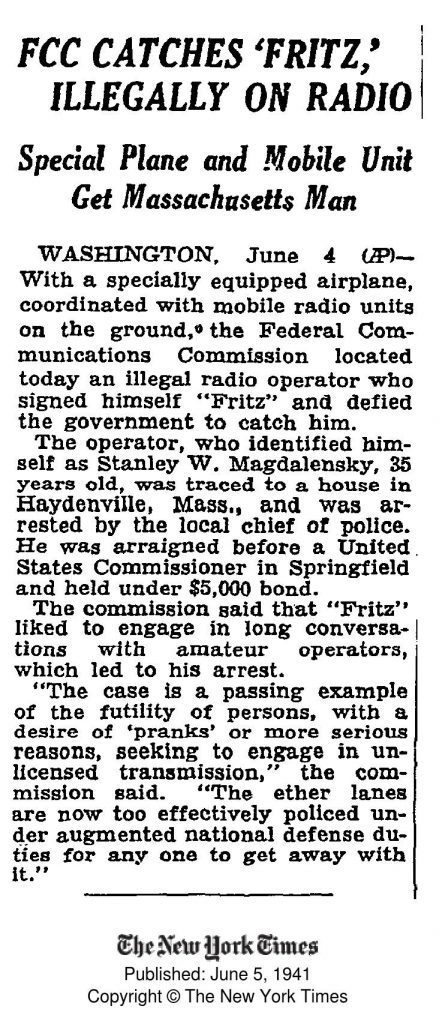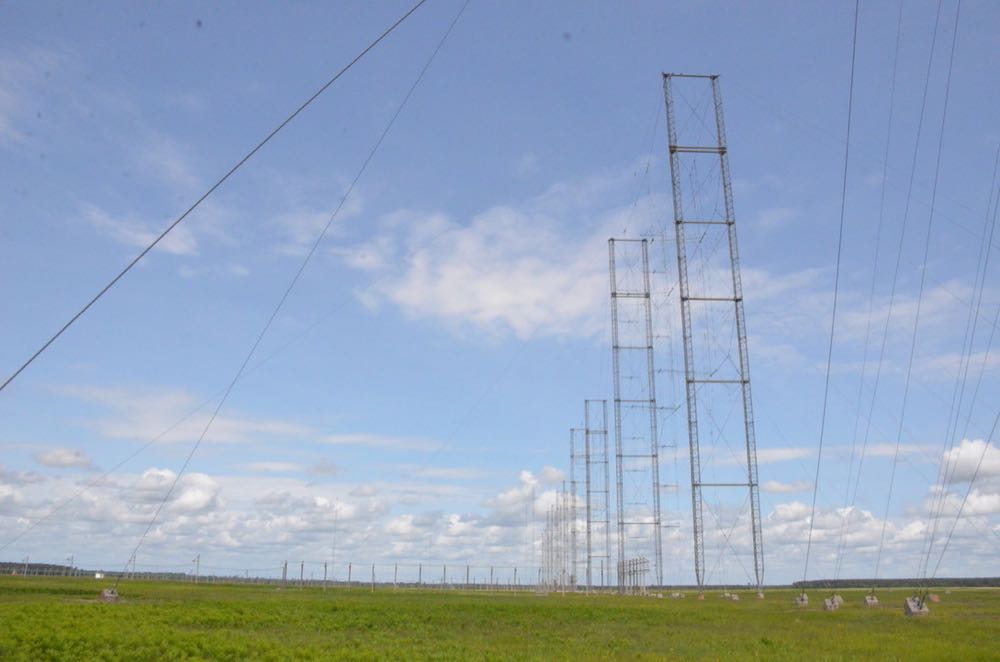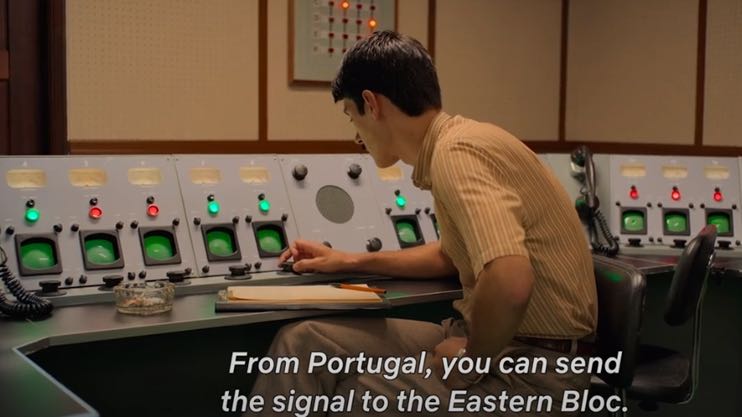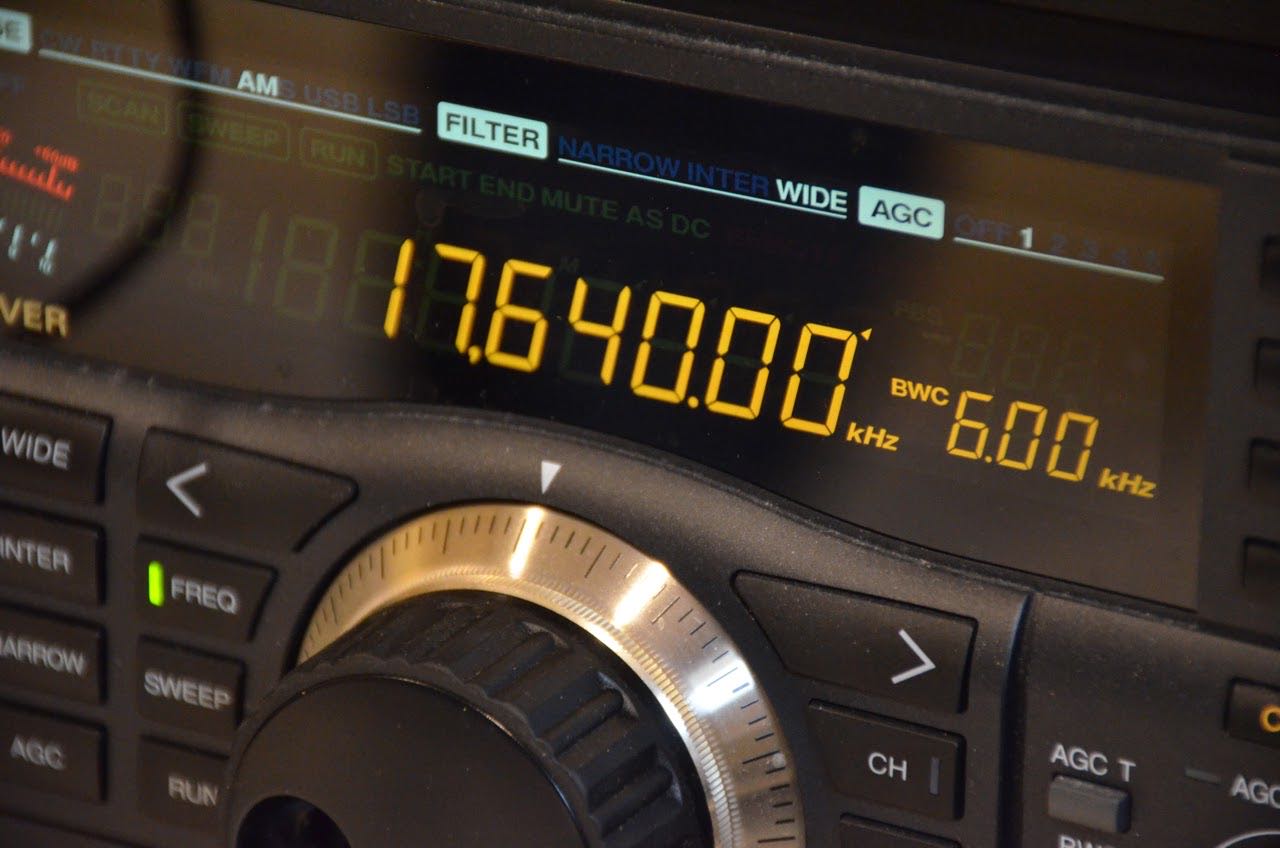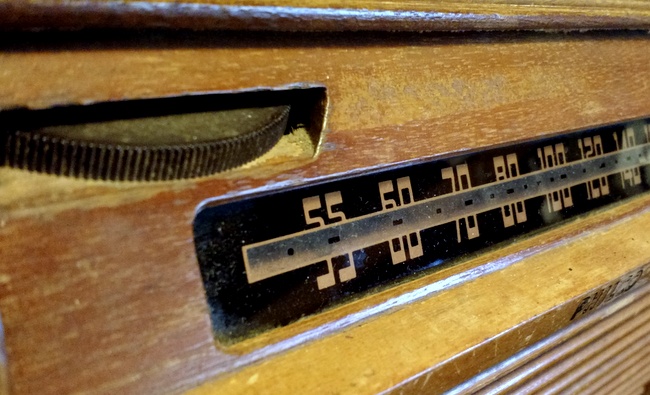Many thanks to SWLing Post contributor, David Goren, who shares this clipping from the New York Times archive:
Tag Archives: NY Times
The Times’s Visual Investigations team: What unencrypted comms reveals about Russian invasion
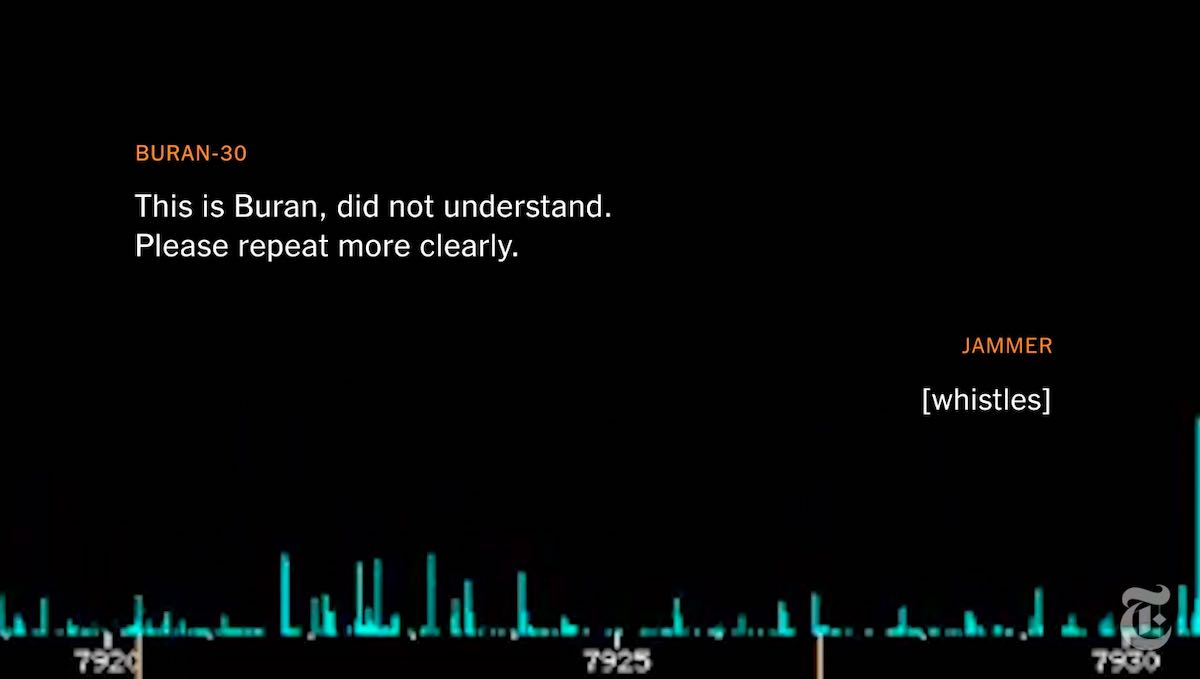 Many thanks to SWLing Post contributor, David Goren, who shares this impressive report from the Times’s Visual Investigations team:
Many thanks to SWLing Post contributor, David Goren, who shares this impressive report from the Times’s Visual Investigations team:
Under Fire, Out of Fuel, No Air Support: What Intercepted Russian Radio Chatter Reveals
The Times’s Visual Investigations team analyzed dozens of battlefield radio transmissions between Russian forces during an initial invasion of the town of Makariv, outside Kyiv. They reveal an army struggling with logistical problems and communication failures.
[Please note: this report includes graphic images and language.]
Radio Waves: Build a Ham Radio Voice Keyer, Sony TFM1000 Decrustification, Shift at RTHK, and RFE Cold War Thriller “Glória”
Radio Waves: Stories Making Waves in the World of Radio
Because I keep my ear to the waves, as well as receive many tips from others who do the same, I find myself privy to radio-related stories that might interest SWLing Post readers. To that end: Welcome to the SWLing Post’s Radio Waves, a collection of links to interesting stories making waves in the world of radio. Enjoy!
Many thanks to SWLing Post contributors Marty, Dennis Dura, Dave Zantow, Al Holt, and Rich Cuff for the following tips:
Build a ham radio voice keyer for the backpack (Nuts and Volts)
I have an MFJ-434 voice keyer that has saved a lot of wear and tear on my vocal cords over the years. It has been a big asset during ham radio contests and when I’ve been calling CQs with reduced power (QRP) transceivers.
One of my new favorite pastimes has been operating QRP radios from remote off-the-grid locations. Most of the time, it’s important to pack only the bare essentials for these mini-DXpeditions. I have never taken the MFJ keyer, primarily due to its size. An “accessory” measuring 6-1/2 x 7 x 2-1/2 inches fills up a lot of backpack. It also weighs a pound and a half. On the other hand, I’m absolutely positive the lack of a keyer has resulted in fewer radio contacts. I always run out of voice before I run out of battery.
Last winter, I was packing a QRP “Go Box” for a trip to Florida. Since that stay was planned to last longer than my normal field trips, I decided to take my MFJ keyer for its first outing. What a difference that keyer made! In less than three months, I worked stations in 31 countries and five continents running a 10 watt transmitter and a dipole antenna!
The enormous number of contacts warranted a closer look at a keyer for shorter field trips. The MFJ-434 has 11 buttons to push, three potentiometers to turn, and two LEDs to show me the keyer is doing what I told it to do. Could I get by with fewer amenities and shrink the size, weight, and power requirements to something more backpack friendly? It was worth an investigation.
The MFJ keyer stores five messages. For field operation, I could live with a single CQ. I found a 20 second record-playback module on eBay for $2.59.
I also found a repeat-cycle timer (variable on and variable off delays) on eBay for $2.38. I could use it to “turn on” the playback message, then turn it “off” for a predetermined period of time before turning it on again.
A relay could be added to key the transmitter’s PTT circuit every time my CQ message was played. The receiver would automatically listen for any replies between messages. (This might actually work!) [Continue reading…]
Sony TFM1000 AM FM SW Vintage Radio Decrustification (YouTube)
Click here to view on YouTube.
Hong Kong Broadcaster’s Swift Turn From Maverick Voice to Official Mouthpiece (NY Times)
RTHK has often set the news agenda with its aggressive coverage of the city. But a Beijing clampdown has changed that, with pro-China coverage filling the void.
HONG KONG — Not long after Patrick Li took over as the government-appointed director of Hong Kong’s public broadcaster, a digital lock pad appeared outside his office entrance.
In the past, the director’s office had been where staffers at the broadcaster, Radio Television Hong Kong, gathered to air grievances with management decisions: programming changes, labor disputes. Now, the lock pad signaled, such complaints were no longer welcome.
For many employees, the closed room was an emblem of the broader transformation sweeping through RTHK, the 93-year-old institution venerated by residents as one of the most trusted news sources in Hong Kong’s once freewheeling media landscape.
RTHK was once compared to the BBC for its fierce editorial independence. But under a sweeping national security law that Beijing imposed last year to silence dissent, many say it now more closely resembles China Central Television, the propagandistic Chinese state broadcaster.[Continue reading…]
‘Gloria’: Netflix’s First Original Series From Portugal Is A Great Spy Thriller (Forbes)
Netflix has released its first Portuguese original series. Glória is on Netflix since November 5. Produced by the SPi production company of Grupo SP Televisão and co-produced with RTP, Glória is an intense historical spy thriller taking place during the Cold War. It is a high-quality series from Portugal with an intricate storyline.
Set in a small Portuguese village named Glória do Ribatejo in the 1960s, the ten-part series follows João Vidal (played by Miguel Nunes), a young man whose family has connections with the leaders of the Estado Novo, the authoritarian Portuguese Regime. João works as an engineer at RARET, a U.S. re-broadcasting office of Radio Free Europe. The series shows how this small village became “an unlikely Cold War stage where American and Soviet forces fought through dangerous sabotage maneuvers to achieve control of Europe,” the Netflix synopsis explains. João gets recruited by the KGB, and will find himself in the middle of the intricate webs of spy games at play in RARET.
An original series created by Pedro Lopes and directed by Tiago Guedes, Glória is a slow-burning series that is a mixture of historical drama based on real events and espionage thriller. The series paints a dark image of Portugal’s past, its violence toward women and its brutal colonial war. It is the highest budget series in the history of Portuguese production, according to The Portugal News. [Continue reading…]
Do you enjoy the SWLing Post?
Please consider supporting us via Patreon or our Coffee Fund!
Your support makes articles like this one possible. Thank you!
Radio Waves: Future of Radio is Relevant, Hams Commemorate KDKA, Listen to the Globe, and Sangean EU Pre-Order for ATS-909X2
Radio Waves: Stories Making Waves in the World of Radio
Because I keep my ear to the waves, as well as receive many tips from others who do the same, I find myself privy to radio-related stories that might interest SWLing Post readers. To that end: Welcome to the SWLing Post’s Radio Waves, a collection of links to interesting stories making waves in the world of radio. Enjoy!
Many thanks to SWLing Post contributors Troy Riedel, Dennis Dura, Mike Hansgen, and Eckhard Hensel for the following tips:
The future of radio is real, relevant and multi-platform (Biz Community)
Exciting new technologies promise to make radio more accessible and engaging than it has ever been. This includes app-based platforms that enable broadcasters to engage with listeners like never before, software that lets producers edit sound as easily as a text document, and a ‘radio station in a bucket’ that turns a mobile phone onto a broadcast hub.
That’s according to radio futurologist James Cridland, who believes that while innovations like these point to a bright future for the over 100-year-old medium, it’ll take more than adopting cool new tech to succeed in the increasingly splintered and diverse arena that radio is evolving into.“Radio is more than just AM and shortwave, more than big, old fashioned transmitters. Radio is a shared experience with a human connection,” he said during a recent webinar on the future of radio hosted by Fabrik, a South African-developed software platform for broadcasters and community groups.
“That shared experience is something that [streaming music service] Spotify can’t offer. It’s something that somebody’s CD player can’t offer,” he said, adding that this also applied to radio stations who just play non-stop music. “There’s no human connection there. There’s no real shared experience.”[…]
Radio Amateurs in Western Pennsylvania to Commemorate KDKA Broadcasting Centennial (ARRL News)
Pittsburgh radio station KDKA will celebrate 100 years of radio broadcasting in November, and Pennsylvania radio amateurs will honor that milestone in a multi-station special event. KDKA dates its broadcasting history to the airing of the Harding-Cox presidential results on November 2, 1920, and the station has been on the air ever since. The special event, which will involve the operation of four stations, will run through the entire month of November.
“More than 100 years ago, many experimenters started delving into a new technology known as wireless, or radio,” said Bob Bastone, WC3O, Radio Officer for the Skyview Radio Society in New Kensington, Pennsylvania. Bastone explained that many of those early pioneers were radio amateurs. “One hundred plus years later, many amateur radio operators are still contributing to wireless technology, while also serving their communities and enhancing international goodwill. Congratulations to KDKA Radio, also known in the early years as amateur radio stations 8XK, 8ZZ, and W8XK.”
Special event stations K3K, K3D, K3A, and W8XK will set up and operate at several locations in Pennsylvania during November. Stations will determine their own modes and schedules. Visit the W8XK profile on QRZ.com for information on certificates and QSLs.
What became KDKA initially began broadcasting in 1916 as amateur radio station 8XK, licensed by the Federal Radio Commission (FRC), the predecessor to the FCC. At the time, amateurs were not prohibited from broadcasting. The small station was operated by Dr. Frank Conrad, who was Westinghouse Electric and Manufacturing Company assistant chief engineer. The transmitter ran 75 W, and the broadcasts gained some popularity in Pittsburgh.
During World War I, amateur radio operation was suspended due to national security concerns. After the war, 8XK was reorganized as a commercial AM radio station, KDKA. The first transmissions of KDKA originated in a makeshift studio on the roof of Westinghouse K Building in East Pittsburgh.
Ham radio clubs participating in the centennial special event include the North Hills Amateur Radio Club in Pittsburgh — which is planning to operate from KDKA’s 1930s’ transmitter site, where an original tower pier still stands. A 1920s’ transmitter site, in Forest Hills, will serve as another operating location. In addition to the North Hills ARC and Skyview Radio Society, other clubs taking part include the Panther Amateur Radio Club, Steel City Amateur Radio Club, the Wireless Association of South Hills, the Butler County Amateur Radio Public Service Group, and the Washington Amateur Communications Radio Club.
Individual radio amateurs will operate from their own stations, and a small group of hams is planning a portable operation from South Park in suburban Pittsburgh.
Stations will invite the public to visit, while observing the required social distancing protocols.
“We amateur radio operators look forward to contacting thousands of other hams around the world to celebrate this huge milestone in the commercial broadcasting industry,” said Bastone. Contact him for more information. — Thanks to ARRL Public Information Officer and Allegheny County ARES Emergency Coordinator Bob Mente, NU3Q, for providing the information for this story.[…]
Listen to the Globe (NY Times)
Radio programming from around the world is available on the internet or through apps.
Americans may not be able to travel the world because of the pandemic, but thousands of foreign radio stations are easily accessible online to bring the world to you.
For Dorothy Parvaz, a radio editor in Washington, D.C., foreign radio was her first introduction to the world beyond Tehran, where she lived until 12. “Listening to radio signals coming in from other countries was just like seeing the world in a way we couldn’t on TV, ” she said. “If I wanted to find music, I went to the apartment downstairs, where one of the kids always got a good signal somehow. We heard Pink Floyd for the first time together.”
Sangean ATS-909X2 once again available for preorder
Many thanks to Eckhard Hensel who notes that the ATS-909X2 is once again on the Sangean EU retailer site for pre-order. The price is €329.00 and they expect the product to ship in the first quarter of 2021.
Do you enjoy the SWLing Post?
Please consider supporting us via Patreon or our Coffee Fund!
Your support makes articles like this one possible. Thank you!
Radio Waves: Radio Afghanistan, Postal Delays, KPH Video, and the Software Defined Radio Academy
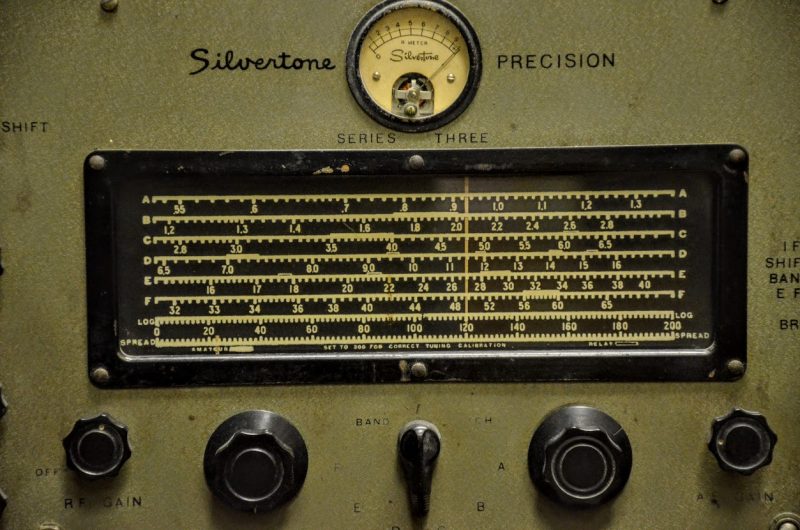 Radio Waves: Stories Making Waves in the World of Radio
Radio Waves: Stories Making Waves in the World of Radio
Because I keep my ear to the waves, as well as receive many tips from others who do the same, I find myself privy to radio-related stories that might interest SWLing Post readers. To that end: Welcome to the SWLing Post’s Radio Waves, a collection of links to interesting stories making waves in the world of radio. Enjoy!
Many thanks to SWLing Post contributors Heath Hall, Tom Daly, and Alexander (DL4NO) for the following tips:
For Decades, This Radio Station Named the Dead. Few Still Listen. (NY Times)
[Note: this article may require login to read at the NY Times]
Afghans once tuned into Radio Afghanistan twice a day to hear the reading of death notices. But in an age of social media, the voice of the nation has lost much of its sway.
KABUL, Afghanistan — Through decades of coups, invasions and endless war, Afghans tuned their radios to Radio Afghanistan every morning at 7 and every afternoon at 4:05 to hear the names of the newly dead.
One of the voices they often heard reading those death notices belongs to Mohamad Agha Zaki, at the mic for the state broadcaster for more than 42 years now. For much of that stretch, his counterpart at the station has been Ziauddin Aziz, the clerk who rushes to Mr. Zaki with the messages the public brings to the station’s small “Death Advertisements” window.
“Ads today?” Mr. Zaki, half asleep, asked on a recent dawn after opening the door to Mr. Aziz’s knock. Outside, birds chirped and the new day’s soft light covered the peaks of the tall pine trees in the station’s compound in Kabul, the capital.
No, said Mr. Aziz, who had waited behind the door in the kind of deference saved for masters of a different era. They had gone weeks without anyone arriving at the little window — just four ads in 40 days, though certainly many more had died.[…]
International Postal Service Disrupted (ARRL News)
The US Postal Service (USPS) has temporarily suspended international mail acceptance for items addressed to certain destinations due to service impacts related to the COVID-19 pandemic. This situation could result in the return or loss of mail, such as QSL cards, addressed to affected parts of the world. The USPS has posted a list of affected countries, which is updated regularly. The Postal Service will, upon request, refund postage and fees on mail bearing a customs stamp that’s returned due to the suspension of service, or the sender may re-mail returned items with existing postage once service has been restored. When re-mailing under this option, customers should cross out the markings “Mail Service Suspended — Return to Sender.”[…]
KPH Coastal Radio Station (Southgate ARC)
In this video Shannon Morse KM6FPP visits coastal radio station KPH which provided ship to shore communications using Morse code. Volunteers have preserved it and operate weekends
Watch The Last Active Morse Code Station in the US – KPH Radio Station
KPH http://www.radiomarine.org/
https://en.wikipedia.org/wiki/KPH_(radio_station)
More information about the Software Defined Radio Academy (Upper-Bavarian Bulletin)
Hamradio online
The Hamradio normally is the largest ham radio exhibition in Europe. But this year it cannot be held.
At the beginning of April, a team around the project manager Markus Heller, DL8RDS, started the project “Hamradio online”. This was only possible as DARC, the German hamradio society, started to introduce electronic collaboration tools long before Corona.
Within this virtual working environment a concept was developed of presentations, distinctions, and more. The program is being prerecorded and will partly be produced as live as possible. Especially the SDR Academy heavily depends on viewer feedback. There will also be videos from the Hamradio Convention that was held last March im Munich. These videos have not been published before.
The infrastructure is being maintained by the teams of the SDR Academy and “Facination Hamradio”. They produce the videos and streamline the installation so all action on the last weekend of June will happen smoothly. These transmissions will be transmitted through several Youtube cannels.
Obviously, personal meetings would be preferable. The advantage of this new solution are the possibly much more participants on both sides: audience and lecturers. The advantage is especially valid for the SDR Academy as most of it is done in English.
Nothing has been finalized. There is a preliminary program in German at https://www.darc.de/fileadmin/filemounts/gs/oeffentlichskeitsarbeit/Veranstaltungen/HAM_RADIO/HAMOnline_Sendeplan.pdf. Lectures held in English are announced in English. I hope an English version of the program will be created.
Do you enjoy the SWLing Post?
Please consider supporting us via Patreon or our Coffee Fund!
Your support makes articles like this one possible. Thank you!
NY Times Op Ed: “My Love Affair With AM Radio”
Many thanks to a number of SWLing Post contributors, including The Professor, Patrick Stenbacka, and Larry W, for sharing a link to this opinion piece in the New York Times by author Erin Aubry Kaplan:
LOS ANGELES — Like many people who grew up in the 1970s, I came of age with AM radio. Everybody I knew — the black kids on my block, the white and Asian kids at my junior high school — followed the Top 40 and discussed the merits of the newest releases by Elton John and Eddie Kendricks.
[…]At home, the kitchen-counter radio was always tuned to KABC. It aired restaurant shows, call-in psychologist shows, news shows, all featuring sophisticated discussions of things I had only vague ideas about. My mother listened while she ironed or cooked or sat at the table paying bills. The radio was her company, and because I admired her (but didn’t quite know how to talk to her), it became mine, too.
To my ears the hosts — people like Michael Jackson, Dr. Toni Grant, Geoff Witcher — sounded like my mother: impassioned but thoughtful, often witty, opinionated but not obnoxiously so.[…]
The Internet and community licenses have changed the London pirate radio scene
Many thanks to SWLing Post contributor, David Korchin (K2WNW), for sharing the following article from The New York Times:
London’s Radio Pirates Changed Music. Then Came the Internet.
LONDON — In 1993, the illegal radio broadcasters at Kool FM came up with a plan to keep the regulators from raiding their studios.
In those days, the rooftops of South and East London still bristled with unauthorized antennas. Installed by pirate radio stations on top of public housing blocks — the city’s tallest and least secure buildings — they transmitted sounds rarely heard on the BBC or commercial stations. Kool FM was at the heart of the scene, broadcasting jungle, rave, and drum and bass music from the Hackney district of East London.
All the pirates needed was a key to the building — easy to buy off a building worker or tenant — and a cheap transmitter. But they had a problem. Illegal broadcasting is, well, illegal, and, in Britain, pirates can face up to two years in prison, unlimited fines, bans from appearing on legal stations and equipment seizures.
So the pirates at Kool FM covered their studio door with concrete. To get in, they had to scale the outside of the building, jumping from balcony to balcony, said one of the station’s founders, who declined to give his real name but who broadcasts as Eastman. On a recent afternoon, he was standing outside Kool’s current studio in a warehouse on London’s outskirts. Drum and bass sounds from a D.J. called Papa G. emanated from behind the wall.
The regulators rarely bother them now, he said, and capers like the one he described are scarce. In the early 1990s, Kool “was the in thing,” said Eastman. But he estimated that Kool has lost 90 percent of its advertising revenue since its heyday. “We’re struggling because it’s hard to raise money to keep the station going.” Kool has recently rebranded as Kool London, and started focusing more on broadcasting online, though its shows still go out on the old pirate FM frequency.
Kool’s problems are part of a broader trend: Ofcom, the British communications regulator, estimated there are now just 50 pirate stations in London, down from about 100 a decade ago, and hundreds in the 1990s, when stations were constantly starting up and shutting down. Ofcom considers this good news, because illegal broadcasters could interfere with radio frequencies used by emergency services and air traffic control, a spokesman said.[…]
[T]wo things happened that changed the landscape of underground radio: first, the internet, and second, new licenses that encouraged pirates to reinvent themselves along more official lines.[…]
Continue reading the full article at The New York Times.
Stream Kool London here:
Stream Reprezent 107.3 here:
Stream Rinse FM here:

